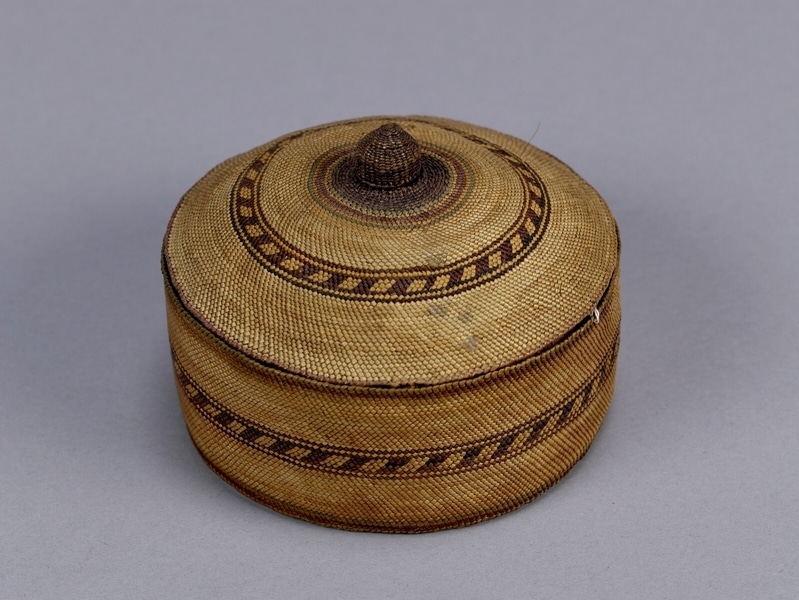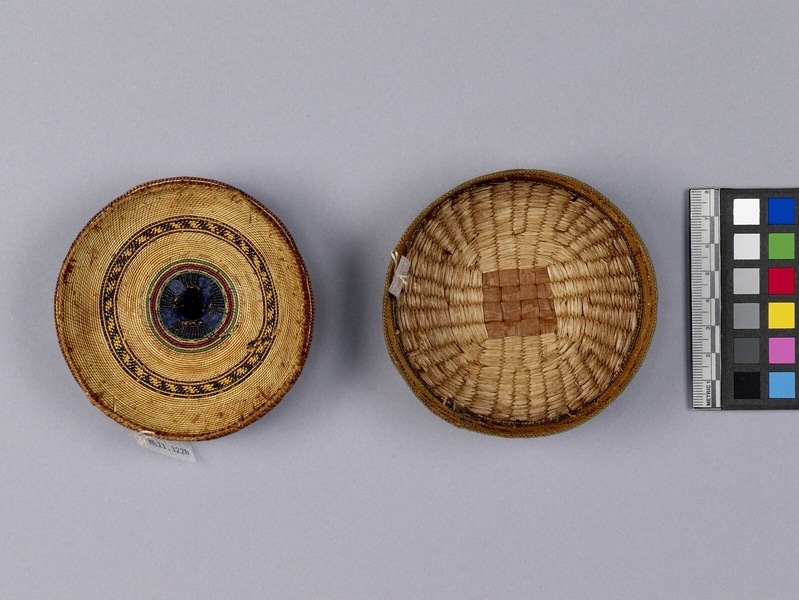Basket Item Number: Nb11.322 a-b from the MOA: University of British Columbia



Description
Round pika-uu (trinket) basket (part a) with wrapped twined grass sides; plain twined base with centre cedar bark checker work. Design around middle is dark blue and yellow geometric between narrow bands of dark blue and yellow. There are five narrow bands around top and bottom edges of basket; green, yellow, purple, yellow and green. Lid (part b) is convex, wrapped twined grass faced with cedar flange loops which fit into basket. A purple knob in centre is surrounded by a wide purple band and narrow bands of dark blue and yellow. Design in centre of lid is dark blue and yellow geometric between narrow bands of dark blue and yellow.
History Of Use
Traditionally, baskets were used for a variety of domestic purposes. In the late 19th century the market for Nuu-chah-nulth and Makah basketry was growing among non-Native collectors. Such sales provided weavers with an impetus for expanded basketry production and an important means of earning subsistence income. In 1904, likely around the time that this basket was made, three accomplished Nuu-chah-nulth weavers -- Ellen Curley, Emma George, and Annie Atlieu Williams -- were invited as part of a group of Nuu-chah-nulth and Kwakwaka’wakw community members to demonstrate their cultural practices to fairgoers from around the world at the Louisiana Purchase Exposition, in St. Louis, Missouri. Photographs document Emma George and Annie Atlieu Williams, posed for the camera, weaving baskets of grasses and cedar-bark similar in style to this one.
Cultural Context
cash economy; craft market
Narrative
This basket was acquired between 1905 and 1916 and passed down within the donor’s family.
Item History
- Made in Vancouver Island, British Columbia, Canada before 1916
- Collected between 1905 and 1916
- Owned by Margaret Gill
- Owned by Helen Gill before April 20, 1978
- Received from Helen Gill (Donor) on April 20, 1978
What
- Name
- Basket
- Identification Number
- Nb11.322 a-b
- Type of Item
- basket
- Material
- cedar bark, aniline dye, bear grass and grass
- Manufacturing Technique
- woven and dyed
- Overall
- height 7.0 cm, diameter 9.5 cm
Who
- Culture
- Nuu-chah-nulth
- Previous Owner
- Margaret Gill and Helen Gill
- Received from
- Helen Gill (Donor)
Where
- Holding Institution
- MOA: University of British Columbia
- Made in
- Vancouver Island, British Columbia, Canada
When
- Creation Date
- before 1916
- Collection Date
- between 1905 and 1916
- Ownership Date
- before April 20, 1978
- Acquisition Date
- on April 20, 1978
Other
- Item Classes
- basketry
- Condition
- fair
- Current Location
- Case 9
- Accession Number
- 0452/0010 a-b